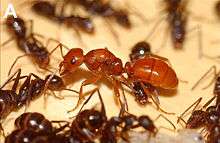Formica archboldi
Formica archboldi is a species of ant in the family Formicidae.[1][2][3][4][5][6][7] They are known for their abnormal behavior, which includes the collection and storage of Odontomachus (trap-jaw) ant skulls.
| Formica archboldi | |
|---|---|
 | |
| Scientific classification | |
| Kingdom: | Animalia |
| Phylum: | Arthropoda |
| Class: | Insecta |
| Order: | Hymenoptera |
| Family: | Formicidae |
| Genus: | Formica |
| Species: | F. archboldi |
| Binomial name | |
| Formica archboldi Smith, 1944 | |
Formica archboldi ants store these severed heads ants in their nests. The Formica archboldi have odors that are chemically similar to the odors of the trap-jaw ants, which might allow the Formica ants to disguise themselves among the trap-jaw ants. The Formica ants immobilize the trap-jaw ants by spraying formic acid, drag them into the nest, and dismember them.[8][9]
Further reading
- Bolton, B. (2016). "Catalogue of the Ants of the World" (PDF). unpublished communication. Retrieved 2019-07-02.
gollark: Consider yellow, a color.
gollark: This is ethical, I checked.
gollark: As world dictator, I will proactively nuke anyone if they would nuke me if they were world dictator.
gollark: Bad.
gollark: Mostly that people are bees and may select on race and stuff if given the option.
References
- "Formica archboldi Report". Integrated Taxonomic Information System. Retrieved 2018-05-07.
- "Formica archboldi species details". Catalogue of Life. Retrieved 2018-05-07.
- "Formica archboldi". GBIF. Retrieved 2018-05-07.
- "Formica archboldi Species Information". BugGuide.net. Retrieved 2018-05-07.
- Ward, Philip S.; Blaimer, Bonnie B.; Fisher, Brian L. (2016). "A revised phylogenetic classification of the ant subfamily Formicinae(Hymenoptera: Formicidae), with resurrection of the genera Colobopsis and Dinomyrmex". Zootaxa. Magnolia Press. 4072 (3): 343–57. doi:10.11646/zootaxa.4072.3.4. PMID 27395929.
- Christopher M. Wilson; Autumn Smith-Herron (2016). "Morphology of the male genitalia of Brachymyrmex and their implications in the Formicinae phylogeny". Journal of Hymenoptera Research. Pensoft Publishers. 50: 81–95. doi:10.3897/JHR.50.8697. ISSN 1070-9428.
- "AntWeb". California Academy of Sciences. Retrieved 2018-05-07.
- "Skull-collecting ants slay with acid". Nature. 2018-11-16. Retrieved 2018-11-19.
- Smith, Adrian (2018-11-16). "Predatory behavior of Florida's skull-collecting ant". ScienceDaily. Retrieved 2018-11-19.
This article is issued from Wikipedia. The text is licensed under Creative Commons - Attribution - Sharealike. Additional terms may apply for the media files.